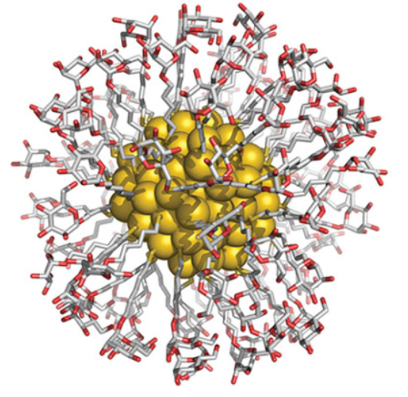Glycans in Nanotechnology
The importance of glycans in nanotechonology

Nanotechnology is technology, science and engineering conducted at the nanoscale, which is about 1 to 100 nanometers, to create, manipulate, and characterize structures on those scales. As it is shown, glycans are applicable biomarkers for medical diagnostic. It is known that material properties are changed on nanoscale. Glyconanomaterials (metal, semiconductor, or carbon-based nanomaterials) show better catalytic, photonic, electronic, or magnetic properties that are not seen in the bulk, while glycans contribute these nanomaterials with water solubility, biocompatibility, and with both passive and active targeting properties. Polysaccharides such as heparin, dextran, chitosan and hyaluronic acid, because of their better biocompatibility, biodegradability, low toxicity, low cost, and the ease of chemical modifications, in comparison with some synthetic materials, have enabled the preparation of polysaccharide-based nanoparticles for pharmaceutical use such as drug delivery carriers.
Gold nanoparticles
Gold nanoparticles (AuNPs) are an important tool for monitoring biological binding events due to easy chemical modification and unique optoelectronic properties. Properties such as hight aqueous solubility/ dispersibility and biocompatibility that AuNPs gain after conjugation with glycans are the basis for novel strategies in bioanalytical applications. Colour changes of AuNPs correlate with the resonance between the incident electromagnetic radiation and collective oscillations of electrons (plasmons), giving rise to localized surface plasmon resonance (LSPR). Resonance frequencies of surface plasmon bands of gold lie in the visible region (400–750 nm) giving rise to colour effects. Enhanced AuNP sensitivity to LSPR and colourimetric changes are facilitated by a high surface area/volume ratio of particles. The colourimetric detection of DNA is allowed by the exploitation of 10–20-nm-sized modified oligonucleotide.
AuNPs are produced by reducing a gold salt in the presence of glycosylated thiol ligands (Figure 1.), also changing conditions, ligand density and composition can be adjusted precisely.

Figure 1. A calculated representation of a 2-nm-sized gold glyconanoparticle formed by 102 gold atoms and coated with 44 molecules of 5-mercaptopentyl α-D-mannopyranoside. (Source: https://www.ncbi.nlm.nih.gov/books/NBK453085/)
Carbon nanotubes
Carbon nanotubes (CNTs) are tubes of hexagonal structure similar to a layer of graphene rolled up into a cylinder on the nanoscale. The outer surface and inner hollow space may be used together to create functionalized CNTs (f-CNTs) to serve as delivery systems. Even though CNTs are cytotoxic and have poor solubility, that can be changed with modification. CNTs are mixed with surfactants or polymers by noncovalent modification. If the CNTs are coated with glycopolymers, then they mimic the mucins. Such CNTs are non-toxic in vitro, while glycopolymer-free CNTs cause death in certain cells. Covalent surface glycosylation or glycoconjugation of CNTs creates in vivo biological probe. Covalent modification by oxidation of the CNT surface is carried out due to the introduction of carboxylic acids, which allow the binding of amino sugars. Galactosylated SWCNTs created in this way can "capture" pathogens of E. coli.


